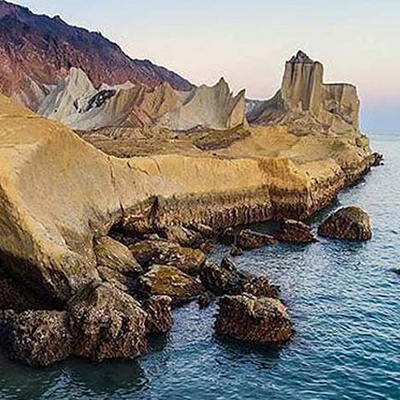Sites
Hormozgan
Emad Ezzatabadi
145 Views
Throughout the eight-year Iran–Iraq War, Hormozgan Province served as one of the country’s main hubs for economic support and military logistics, owing to the proximity to the Strait of Hormuz and its key islands in the Persian Gulf. Located in southern Iran, Hormozgan borders the northern coast of the Persian Gulf and part of the Gulf of Oman, with Bandar Abbas as its capital.[1] Hormozgan Province borders Kerman to the north; Kerman and Sistan and Baluchestan to the east; and Bushehr Province to the west. Also, the Makran Sea lies to its southeast, while the Persian Gulf forms the province’s southern and southwestern maritime border.[2]
According to the 2011 census, Hormozgan had a population of over 1.5 million. The climate is hot and dry in the northern and northeastern parts of the province, while the southern and southwestern regions experience hot and humid conditions. Hormozgan consists of thirteen counties: Abumusa, Qeshm, Bastak, Bashagard, Sirik, Jask, Minab, Rudan, Khamir, Parsian, Bandar Abbas, Bandar Lengeh, and Hajjiabad, along with fourteen islands: Qeshm, Hormuz, Larak, Hengam, Kish, Lavan, Siri, Greater and Lesser Farurs, Hendurabi, Shator, Abumusa, and Greater and Lesser Tunbs—all located in the Persian Gulf.[3]
Common economic activities in Hormozgan include agriculture, fishing, and trade. The province is also rich in natural resources, including oil, gas, chromite, steel, aluminum, and red soil. In addition, Hormozgan holds a key position in maritime transport and the fisheries industry.[4]
In 1967, the General Governorate of Ports and Islands of the Persian Gulf and the Gulf of Oman was established in Bandar Abbas. On September 27, 1976, the name “Hormozgan” was officially adopted, reflecting the province’s connection to the Strait of Hormuz.[5]
With the outbreak of the Iran–Iraq War on September 22, 1980, Hormozgan became even more strategically important. It’s 1500 kilometers of coastline—from the Makran Sea in the east to the Persian Gulf in the west—and islands like Siri, Hormuz, Abu Musa, and the Greater and Lesser Tunbs underlined its strategic position. As the major ports of Khorramshahr and Abadan came under enemy attack, Bandar Abbas—with its Shahid Bahonar and Shahid Rajaei ports—took over the country’s import operations and became the main substitute for the ports in Khuzestan. Its distance from the frontlines made Hormozgan a suitable hub for logistical support. Accordingly, the War Support Headquarters of the Jahad-e Sazandegi Organization established a logistics branch on Hormuz Island early in the Iran–Iraq War to support operational needs and ensure supply continuity. The first group of forces from Hormozgan was deployed to the frontlines on November 14, 1980.[6] At that time, the Hormozgan branch of the Islamic Revolutionary Guard Corps (IRGC) was part of the IRGC Region 6, operating under the command of the 41st Tharallah (as) Division based in Kerman.[7] On March 21, 1986, Al-Zahra (sa) Battalion 422, a dedicated unit of Hormozgani volunteers, was formed by Mansour Nabizadeh.[8] Due to their familiarity with water, they would take part in amphibious operations. Boat operators from this province played a key role in operations Kheibar and Valfajr 8, and Hormozgani divers made significant contributions in operations Karbala 4 and 5.[9] They also participated in land-based operations as the 41st Tharallah (as) Division, the 19th Fajr Division, Imam Hussain (as) Division, and the 33rd Al-Mahdi (as) Brigade[10] in addition to other ones, including Fath al-Mubin and Tariq al-Quds.
Forces were deployed from Hormozgan to almost all operational areas, including Zeyd Outpost, Khorramshahr, oil platforms, Khark Island, Fakkeh, east of the Tigris River, Zubeidat, Bostan, Dasht-e Abbas, Karkheh Noor, Chazzabeh, Umm al-Rasas, Al-Sakhrah, Shatt-Ali, the Majnoon islands, Marivan, Qasr-e Shirin, and Saqqez.
Hormozgan Province played a central role in the naval conflict. In the Strait of Hormuz—through which commercial fleets belonging to the Baathist regime and those of its regional allies such as Kuwait and Saudi Arabia, as well as U.S. naval forces, routinely passed—Hormozgan naval units used fast-moving boats to carry out operations that disrupted the security of enemy vessels and their regional supporters.[11] One of the most significant confrontations occurred on April 18, 1988, when the U.S. Navy attacked the Salman Oil Platform (south of Lavan Island) and the Nasr Platform (southeast of Siri Island), both located in Hormozgan waters.[12]
In retaliation, IRGC fast-moving boats, operating from positions near Abu Musa Island, launched counterattacks targeting the Mobarak Oil Platform and several other strategic sites.[13] Meanwhile, Iranian Navy vessels from the Army First Naval District—destroyers Sahand, Sabalan, and the frigate Joshan—engaged U.S. forces. During the battle, a U.S. helicopter was shot down, Joshan and Sahand were sunk, and Sabalan was damaged.[14] Among the martyrs of this operation were Ali Zare Nemati and Ebrahim Harabadi, who were serving aboard the Joshan missile boat; Abbas Afifeh, Hamid Qahremani Arjasi, and Reza Soltani, the crew members of the Sahand vessel;[15] and Asadollah Raeisi and Eshaq Dara of the IRGC Navy, who directly targeted a U.S. Cobra helicopter.[16]
At 10:22 AM on July 3, 1988, Iran Air Flight 655, en route from Bandar Abbas to Dubai, was shot down near Hormuz Island by the USS Vincennes, resulting in the martyrdom of all 290 passengers and crew members aboard.[17] After the attack, the forces of the Iranian Navy, the IRGC, Army Aviation, and local volunteers recovered the martyrs’ bodies from the sea and transferred them to Bandar Abbas.[18]
During the war, Bandar Abbas hosted many war-displaced civilians, primarily from Khuzestan. They were settled in the 22 Bahman neighborhood. Throughout the Iran-Iraq War, 1248 people from Hormozgan Province were martyred, 2476 were injured, and 341 were taken as prisoners of war. Hormuz Island, with 39 martyrs, holds the highest martyr-to-population ratio in Iran.[19]
Notable Martyrs from Hormozgan include Fatemeh Nik, known as Umm al-Shuhada of Iran, who lost nine family members—including three sons—in the war. She was martyred in the 1987 Mecca Incident, when Saudi forces attacked Iranian pilgrims during the annual demonstration known as Dissociation from the Polytheists.[20]
Other Hormozgani martyrs include Ali-Reza Armat, a volunteer from Minab Basij Unit, Ali Hajebi, deputy commander of the 41st Tharallah (as) Division, Gholamshah Zakeri, commander of Qeshm Island IRGC Unit, pilot Masoud Muhammadi, commander of the 91st Tactical Fighter Squadron at Bandar Abbas Airbase.[21]
Following the war, Hormozgan entered a new phase of reconstruction and development. In 1992, the construction of a sponge iron plant began in Qeshm and Bandar Abbas Oil Refinery was inaugurated in 1993.[22] Other major industries developed after the war include the Hormozgan Aluminum and Cement Plant and the Iran Shipbuilding and Offshore Industries Complex. These developments, along with Hormozgan’s strategic location on the western edge of Bandar Abbas, have turned this province into Iran’s Economic Capital. In 2019, the Bandar Abbas International Airport was renamed Martyrs of Flight 655 in honor of the 290 victims of Iran Air Flight 655. Next year, a memorial was unveiled on Hormuz Island to honor the martyred border guards. Also, the memorial site for the Flight 655 martyrs, located on the eastern coast of Bandar Abbas near the airport, is still under construction.[23]
[1] Saibani, Ahmad, Joghrafiya-ye Tarikhi-ye Hormozgan (Historical Geography of Hormozgan), Bandar Abbas: Nasim-e Badgir, 1399, p. 20.
[2] Afshar Sistani, Iraj, Ostan-e Hormozgan (Hormozgan Province), Tehran: Hirmand, p. 69.
[3] Saibani, Ahmad, Ibid., Pp. 21–26.
[4] Muhammadian-e Koukhardi, Muhammad, Shahrestan-e Bastak va Bakhsh-e Koukhard (Bastak County and Koukhard District), Vol. 1, Dubai, 2005 AD.
[5] Afshar Sistani, Iraj, Ibid., Pp. 111–112.
[6] Rooznameh-ye Sobh-e Sahel (Sobh-e Sahel Newspaper), Year 25th, No. 4144, Shanbeh 5 Mehr 1399, p. 2.
[7] Mirzaei, Abbas, Atlas-e Yegani-ye Lashkar 41 Tharallah (as) dar 8 Sal Defa Muqaddas (Unit Atlas of 41 Tharallah (as) Division during 8 Years of Sacred Defense), Tehran: Markaz-e Chap-e Asnad va Tahqiqat-e Defa Muqaddas, 1395, p. 8.
[8] Keykha, Ali, Nabard-e Faw al-Bahar (Battle of Faw Al-Bahar), Bandar Abbas: Rasoul, 1400, p. 37.
[9] Faslname-ye Khatshekanan-e Khalij-e Fars (Khatshekanan-e Khalij-e Fars Quarterly), Year 1st, No. 2, Zemestan 1394, Pp. 12, 14.
[10] Rooznameh-ye Sobh-e Sahel (Sobh-e Sahel Newspaper), Ibid.
[11] Daftar-e Pazhuhesh-haye Farhangi-ye Bonyad-e Shahid va Omur-e Isargaran, Farhang-e Alam-e Shuhada-ye Ostan-e Hormozgan (Dictionary of Martyrs’ Names of Hormozgan Province), Tehran: Shahed, 1393, p. 43.
[12] Daneshname-ye Amaliat-haye Mandegar-e Niroo-ye Daryayi-ye Rahbordi-ye Artesh-e Jomhuri-ye Eslami-ye Iran dar Doran-e Defa Muqaddas (Encyclopedia of Lasting Operations of the Strategic Naval Forces of the Islamic Republic of Iran Army during the Sacred Defense), Tehran: Sooreh Mehr, 1398, p. 213 with additions.
[13] Eqdamat va Natayej-e Amaliat-e Niroo-ye Daryayi Artesh-e Jomhuri-ye Eslami-ye Iran dar Moqabele ba Tajavozat va Modakhelat-e Araq va Niroohaye Faramanateqei dar Khalij-e Fars (Actions and Results of Naval Operations of the Islamic Republic of Iran Army against Iraqi and Extra-regional Forces in the Persian Gulf), Soleimani Savadkouhi, Shahrokh, Tehran: Dafous, 1397, p. 326.
[14] Daneshname-ye Amaliat-haye Mandegar-e Niroo-ye Daryayi Rahbordi (Encyclopedia of Lasting Operations of the Strategic Naval Forces), Ibid., Pp. 208, 212, 213 with additions.
[15] Ibid., Pp. 400, 403.
[16] Faslname-ye Khatshekanan-e Khalij-e Fars (Khatshekanan-e Khalij-e Fars Quarterly), Ibid., p. 14 with additions.
[17] Mahname-ye Sanaye-ye Havaie (Aviation Industries Monthly), Year 26th, No. 298, Tir 1395, Pp. 26, 27.
[18] Faslname-ye Khatshekanan-e Khalij-e Fars (Khatshekanan-e Khalij-e Fars Quarterly), Ibid., p. 33.
[19] Daftar-e Pazhuhesh-haye Farhangi-ye Bonyad-e Shahid va Omur-e Isargaran, Farhang-e Alam-e Shuhada-ye Ostan-e Hormozgan (Dictionary of Martyrs’ Names of Hormozgan Province), Ibid.
[20] Baghlani, Mohsen, Motavaled-e Mah-e Mehr Qesse-ye Dokhtara-ye Khoob (Born in October: The Story of Good Girls), Vol. 1, Tehran: Qadr-e Velayat, 1397, Pp. 33, 34.
[21] Faslname-ye Khatshekanan-e Khalij-e Fars (Khatshekanan-e Khalij-e Fars Quarterly), No. 8, Paeez 1396, p. 23.
[22] Afshar Sistani, Iraj, Ibid., p. 396.
[23] Faslname-ye Khatshekanan-e Khalij-e Fars: Pivast-e Rahiyan-e Noor-e Daryayie (Khatshekanan-e Khalij-e Fars Quarterly: Naval Rahiyan-e Noor Chapter).





